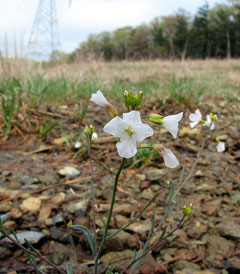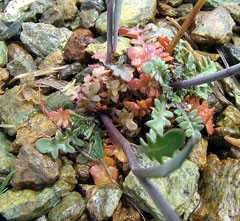 |
|
http://flickr.com/photos/49503155549@N01 |
 |
| http://flickr.com/photos/49503155549@N01 |
Translate this page:
Summary
Physical Characteristics

 Arabis lyrata is a BIENNIAL/PERENNIAL growing to 0.3 m (1ft).
Arabis lyrata is a BIENNIAL/PERENNIAL growing to 0.3 m (1ft).
See above for USDA hardiness. It is hardy to UK zone 5 and is not frost tender. The species is hermaphrodite (has both male and female organs) and is pollinated by Bees, Lepidoptera (Moths & Butterflies).
Suitable for: light (sandy), medium (loamy) and heavy (clay) soils and prefers well-drained soil. Suitable pH: mildly acid, neutral and basic (mildly alkaline) soils. It can grow in semi-shade (light woodland) or no shade. It prefers dry or moist soil.
UK Hardiness Map
US Hardiness Map
Synonyms
Plant Habitats
Cultivated Beds; East Wall. In. South Wall. In. West Wall. In.
Edible Uses
Edible Parts: Leaves
Edible Uses:
Young leaves - raw or cooked[177]. Rosettes of the lobed leaves are added to tossed salads or served as a green vegetable[257].
References More on Edible Uses
Medicinal Uses
Plants For A Future can not take any responsibility for any adverse effects from the use of plants. Always seek advice from a professional before using a plant medicinally.
None known
References More on Medicinal Uses
The Bookshop: Edible Plant Books
Our Latest books on Perennial Plants For Food Forests and Permaculture Gardens in paperback or digital formats.

Edible Tropical Plants
Food Forest Plants for Hotter Conditions: 250+ Plants For Tropical Food Forests & Permaculture Gardens.
More

Edible Temperate Plants
Plants for Your Food Forest: 500 Plants for Temperate Food Forests & Permaculture Gardens.
More

More Books
PFAF have eight books available in paperback and digital formats. Browse the shop for more information.
Shop Now
Other Uses
References More on Other Uses
Cultivation details
We have very little information on this species and do not know if it will be hardy in Britain, though judging by its native range it should succeed outdoors in many parts of this country. This species of rockcress is considered an important first brood nectar plant for 'Karner Blue' butterfly (Lycaeides melissa samuelis Nabokov), an endangered species in North America. The following notes are based on the general needs of the genus. Easily grown in ordinary well-drained soil[1].
References Carbon Farming Information and Carbon Sequestration Information
Temperature Converter
Type a value in the Celsius field to convert the value to Fahrenheit:
Fahrenheit:
The PFAF Bookshop
Plants For A Future have a number of books available in paperback and digital form. Book titles include Edible Plants, Edible Perennials, Edible Trees,Edible Shrubs, Woodland Gardening, and Temperate Food Forest Plants. Our new book is Food Forest Plants For Hotter Conditions (Tropical and Sub-Tropical).
Shop Now
Plant Propagation
Seed - it is best to surface sow the seed as soon as it is ripe in a light position in a cold frame[134]. Seed can also be sown in spring. It usually germinates in 2 - 3 weeks at 21°c[134]. When large enough to handle, prick the seedlings out into individual pots and plant them out in the summer. Division after flowering[111]. Very easy, the divisions can be planted out straight into their permanent positions if required. Cuttings in a shady border in summer[1].
Other Names
If available other names are mentioned here
Native Range
NORTHERN AMERICA: Canada (Ontario (south), Saskatchewan, Alberta, Manitoba, British Columbia), United States (Connecticut, Indiana, Massachusetts (west), Michigan, New Jersey, New York, Ohio, Pennsylvania, Vermont (southwest), Illinois, Iowa, Minnesota (east), Missouri, Wisconsin, Delaware, Georgia, Kentucky, Maryland (west), North Carolina (west), Tennessee (east), Virginia (west))
Weed Potential
Right plant wrong place. We are currently updating this section.
Please note that a plant may be invasive in one area but may not in your area so it's worth checking.
Conservation Status
IUCN Red List of Threatened Plants Status :

Growth: S = slow M = medium F = fast. Soil: L = light (sandy) M = medium H = heavy (clay). pH: A = acid N = neutral B = basic (alkaline). Shade: F = full shade S = semi-shade N = no shade. Moisture: D = dry M = Moist We = wet Wa = water.
Now available:
Food Forest Plants for Mediterranean Conditions
350+ Perennial Plants For Mediterranean and Drier Food Forests and Permaculture Gardens.
[Paperback and eBook]
This is the third in Plants For A Future's series of plant guides for food forests tailored to
specific climate zones. Following volumes on temperate and tropical ecosystems, this book focuses
on species suited to Mediterranean conditions—regions with hot, dry summers and cool, wet winters,
often facing the added challenge of climate change.
Read More
Expert comment
Author
L.
Botanical References
43235
Links / References
For a list of references used on this page please go here
Readers comment
© 2010, Plants For A Future. Plants For A Future is a charitable company limited by guarantee, registered in England and Wales. Charity No. 1057719, Company No. 3204567.